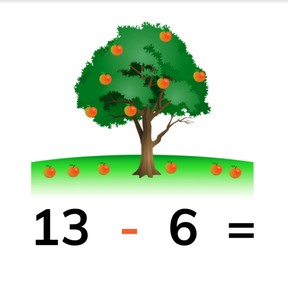



8,000 schools use Gynzy
92,000 teachers use Gynzy
1,600,000 students use Gynzy
General
Students learn to subtract numbers to 20 and can choose to split the second number (minuend) to subtract to ten and then take away the rest.
Common core standard(s)
1.OA.C
Relevance
It is important to be able to subtract to 20, so you can determine how many you have left. For example if there are 13 apples in the tree and 6 fall out, you then know that there are 7 apples left in the tree.
Introduction
The interactive whiteboard shows a number line showing a number of jumps. Ask the students to determine which number is jumped to. Next, ask students to count the ice cubes and to say how many tens and ones there are. Erase the grey boxes to show the answers.
Development
Discuss with student that you start subtraction by first counting how many you have in total. This is the first number in your subtraction problem (the minuend). Then you look to see how many are taken away. This is the second number of your subtraction problem (the subtrahend). When you take the second number away from the first you are left with the difference. Show this using the ice cubes on the interactive whiteboard and the cake with candles. Check that students are able to calculate visually by asking them to solve the subtraction problems with cans and bananas. Ask them what subtraction problem they solved. Next tell students that you can't always see the objects you are counting, sometimes you only see numbers. And then you can solve the subtraction problem in many ways. You can use the rekenrek or blocks, or count back on a number line. You can also look to see how many you must add to the second number to total the first, or you can decompose the second number (subtrahend) and subtract to 10 and then take away the rest. Give students a set of subtraction problems and ask them how they solved the problems. Remind the class that one way is not better than another, and that they should use the method that works best for them. Finally show students how to solve a story problem. They first determine what kind of math problem it is, which numbers are needed for the math problem, they say or write the problem, and then solve the problem. Do one together and then ask students to solve a story problem.
Check that students are able to subtract numbers to 20 crossing ten by asking the following questions:
- What are the steps of solving a story problem?
- How do you solve 13 - 9?
Guided practice
Students first practice subtracting with visual support. Then they are only given the numbers, and finally students are asked to solve a story problem. Ask students how they determine which numbers to use and what the difference is.
Closing
Discuss with students that it is important to be able to subtract numbers to 20 because you can then determine how many objects you have left after some are taken away. Next, show an image on the interactive whiteboard and ask the students which subtraction problem matches the image. Ask them to find the difference. Then match the subtraction problems to their differences.
Teaching tips
Students who have difficulty with subtraction can make use of manipulatives, like MAB blocks. Have them set out the number of blocks shown by the subtraction problem and then take the blocks away and count how many are left. Repeat with various subtraction problems.
Instruction materials
optional: MAB blocks or manipulatives
The online teaching platform for interactive whiteboards and displays in schools
Save time building lessons
Manage the classroom more efficiently
Increase student engagement
Discover more!
About Gynzy
Gynzy is an online teaching platform for interactive whiteboards and displays in schools.
With a focus on elementary education, Gynzy’s Whiteboard, digital tools, and activities make it easy for teachers to save time building lessons, increase student engagement, and make classroom management more efficient.



